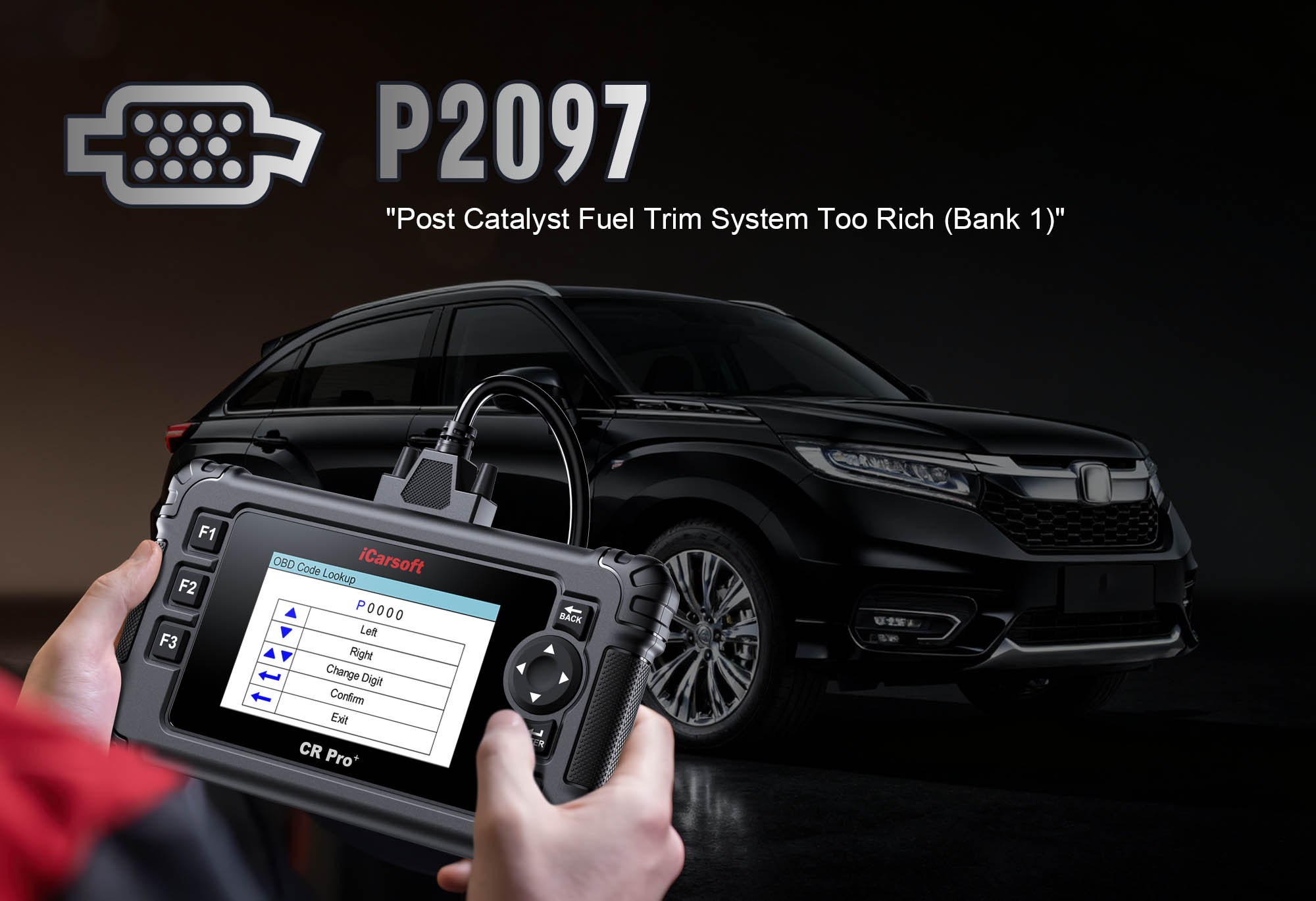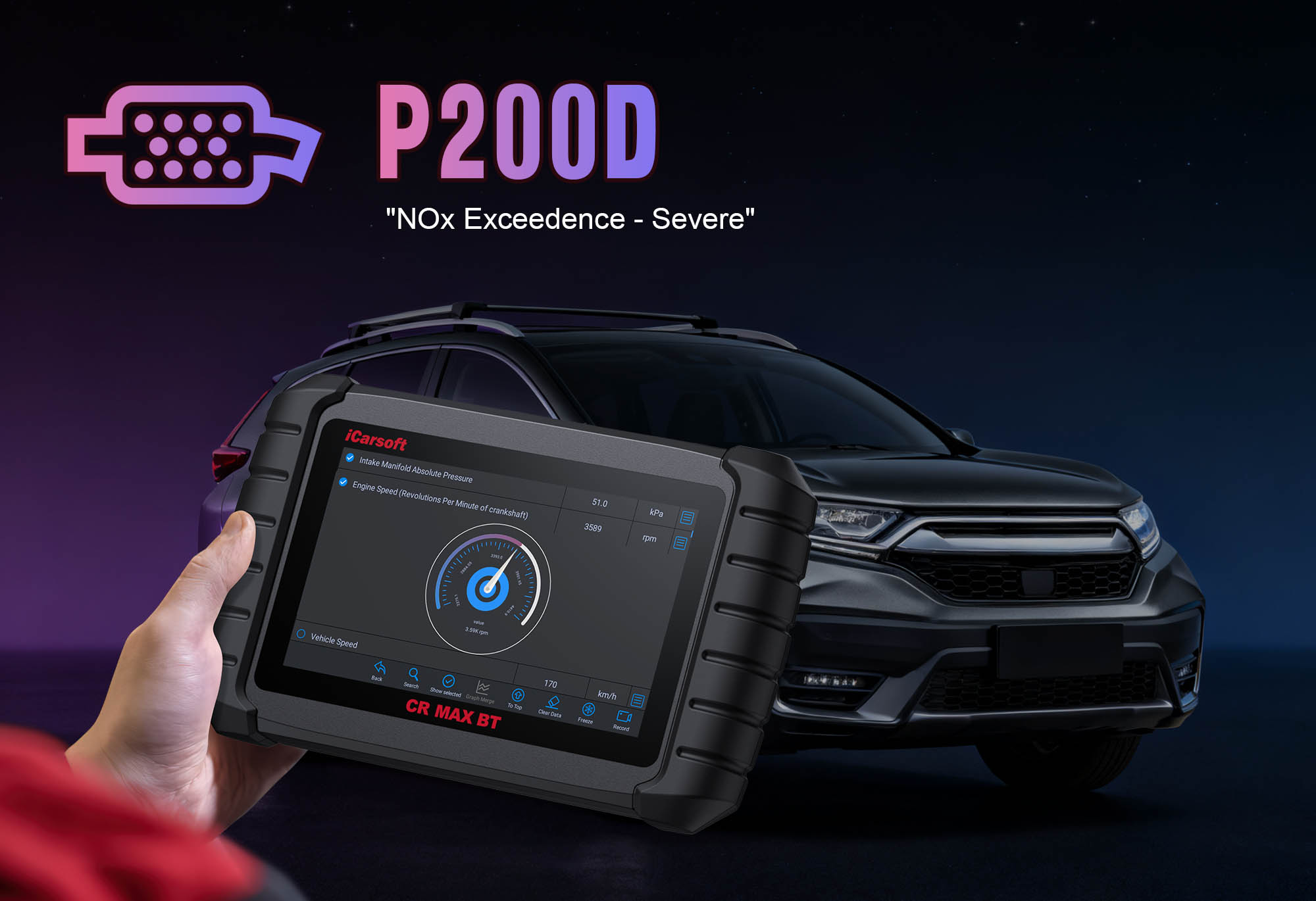Diagnose & Clear P2097 with iCarsoft CR Pro+: Fix Post-Catalyst Fuel Trim Too Rich (Bank 2)
If your check engine light illuminates and a scan returns P2097, your vehicle’s emissions and fuel systems are signaling an imbalance in the air-fuel mixture for Bank 2. This generic OBD-II code stands for "Post-Catalyst Fuel Trim System Too Rich (Bank 2)"—meaning the Engine Control Module (ECM) has detected that exhaust gases leaving the catalytic converter (post-catalyst) in Bank 2 contain excessive unburned fuel, indicating a rich mixture.
Modern engines rely on a network of oxygen (O2) sensors to maintain optimal combustion: upstream sensors (before the catalyst) monitor raw exhaust to adjust fuel injection, while downstream sensors (after the catalyst) verify the catalyst’s efficiency. When P2097 occurs, the downstream sensor in Bank 2 detects excess fuel in post-catalyst exhaust, suggesting the upstream sensor’s adjustments aren’t correcting the rich condition or the catalyst itself is failing to burn residual fuel. Left unaddressed, this causes reduced fuel economy, increased emissions, and premature catalytic converter damage.
Basic scanners might only label P2097 as a "rich fuel trim fault" but can’t compare upstream/downstream sensor data or isolate issues to Bank 2. The iCarsoft CR Pro+—with its bank-specific fuel trim analysis, dual O2 sensor monitoring, and injector activation tests—solves this. Let’s walk through how to diagnose and resolve P2097.
 iCarsoft CR Pro+ displaying Bank 2 upstream/downstream O2 sensor data and fuel trim for P2097
iCarsoft CR Pro+ displaying Bank 2 upstream/downstream O2 sensor data and fuel trim for P2097
Understanding P2097: Causes & Key Symptoms
To tackle P2097 effectively, recognize how a rich post-catalyst mixture impacts Bank 2 and overall engine health:
Key Symptoms of P2097
-
Check Engine Light: Illuminates when Bank 2’s post-catalyst fuel trim values remain below -10% (rich threshold) for 5+ consecutive minutes of driving.
-
Reduced Fuel Efficiency: A rich mixture wastes fuel—expect 10–15% lower MPG (e.g., dropping from 28 MPG to 24 MPG).
-
Rough Idle & Hesitation: Unburned fuel in Bank 2 disrupts combustion, causing vibrations at idle or lag during acceleration.
-
Strong Fuel Odor: Excess fuel in exhaust creates a noticeable gasoline smell, especially prominent during startup.
-
Catalytic Converter Overheating: Unburned fuel ignites inside the catalyst, raising temperatures and risking internal damage (signaled by a hot, glowing converter).
-
Failed Emissions Tests: High hydrocarbon (HC) and carbon monoxide (CO) levels from rich exhaust cause test failures.
Common Causes of P2097
|
Cause
|
Description
|
|
Faulty Upstream O2 Sensor (Bank 2, Sensor 1)
|
A worn or contaminated sensor sends incorrect "lean" data to the ECM, leading to over-fueling in Bank 2 (accounts for ~35% of P2097 cases).
|
|
Leaking Fuel Injectors (Bank 2)
|
Stuck-open injectors deliver too much fuel to Bank 2 cylinders, overwhelming combustion and leaving unburned fuel for the catalyst.
|
|
Clogged Fuel Pressure Regulator
|
A stuck regulator maintains high fuel pressure, forcing excess fuel into Bank 2 injectors regardless of ECM commands.
|
|
Dirty Mass Air Flow (MAF) Sensor
|
A contaminated MAF underreports airflow to the ECM, tricking it into adding unnecessary fuel to Bank 2 to "balance" the air-fuel ratio.
|
|
Failing Catalyst (Bank 2)
|
A degraded catalyst loses its ability to burn residual fuel, leading to rich post-catalyst exhaust (confirmed by matching upstream/downstream O2 signals).
|
|
Vacuum Leaks (Bank 1)
|
Leaks in Bank 1 cause the ECM to overcompensate by enriching the entire fuel system—disproportionately affecting Bank 2’s mixture.
|
Why iCarsoft CR Pro+ Excels at Diagnosing P2097
The CR Pro+ outperforms basic tools with features tailored to bank-specific fuel and emissions diagnostics—critical for pinpointing P2097’s root cause:
Dual O2 Sensor Data Comparison
Displays real-time readings from upstream (Bank 2, Sensor 1) and downstream (Bank 2, Sensor 2) O2 sensors, highlighting discrepancies that confirm rich post-catalyst exhaust.
Bank-Specific Fuel Trim Analysis
Breaks down short-term (STFT) and long-term (LTFT) fuel trim for Bank 2—values below -10% quantify richness and confirm P2097.
Fuel Injector Activation Tests
Bi-directionally controls individual Bank 2 injectors to detect leaks or sticking—no physical disassembly needed (hears "clicks" and monitors pressure drops).
Catalyst Efficiency Testing
Evaluates post-catalyst exhaust by comparing upstream/downstream O2 activity—avoids unnecessary catalyst replacement by confirming if it’s functioning.
Vehicle-Specific Component Diagrams
Preloaded with Bank 2 cylinder layouts, O2 sensor locations, and injector positions for 65+ makes (e.g., Audi Q5, Dodge Charger, Nissan Altima).
MAF Sensor Validation
Measures airflow accuracy against vehicle-specific targets—rules out contamination as a cause of over-fueling in Bank 2.
Step-by-Step: Diagnose P2097 with iCarsoft CR Pro+
-
1. Connect & Confirm the Code
Plug the CR Pro+ into your vehicle’s OBD-II port (under the dashboard) and power it on.
Select your vehicle via Auto VIN Scan (reads your VIN in 2 seconds) or manual entry (make/model/year/engine).
Navigate to Engine > Fault Codes > Read Codes to confirm P2097. Tap Code Details for vehicle-specific info (e.g., "Audi: Bank 2 Post-Catalyst LTFT = -16% – Rich Mixture Detected").
-
2. Identify Bank 2 Cylinders
First, confirm which cylinders belong to Bank 2 using the CR Pro+:
Navigate to Component Location > Engine > Cylinder Banks.
The scanner displays:
For V-engines (V6, V8), Bank 2 = cylinders farthest from the front (e.g., V8: Bank 1 = 1-2-3-4, Bank 2 = 5-6-7-8).
For inline engines (4/6-cyl), Bank 2 only exists in rare dual-bank setups (e.g., some high-performance 4-cylinders like Volkswagen Golf R).
Mark Bank 2 locations to focus inspections on relevant components.
-
3. Analyze Live Fuel Trim & O2 Sensor Data
The CR Pro+’s real-time data pinpoints the source of Bank 2’s richness:
Start the engine and let it reach operating temperature (10–15 minutes, coolant temp ≥180°F).
Navigate to Engine > Live Data > Fuel System and select Bank 2 parameters:
"Short-Term Fuel Trim (STFT)": Should fluctuate between -5% and +5%. Persistent values < -10% = active rich condition.
"Long-Term Fuel Trim (LTFT)": Should stay between -10% and +10%. Values < -10% = chronic richness.
"Upstream O2 Sensor Voltage (Bank 2, Sensor 1)": Normal = 0.1–0.9V (rapid fluctuations). Steady high voltage (>0.8V) = rich raw exhaust.
"Downstream O2 Sensor Voltage (Bank 2, Sensor 2)": Normal = 0.4–0.6V (stable). Steady high voltage (>0.7V) = rich post-catalyst exhaust.
Compare Bank 2 to Bank 1 (if applicable):
Only Bank 2 is rich = issue isolated to Bank 2 components (injectors, O2 sensor).
Both banks rich = systemic problem (fuel pressure, MAF sensor).
-
4. Test the Bank 2 Upstream O2 Sensor
A faulty upstream sensor is the top cause of P2097—verify with the CR Pro+:
Response Test:
Go to Special Functions > Sensors > O2 Sensor Response Test.
The scanner monitors how quickly the Bank 2, Sensor 1 switches between lean (0.1V) and rich (0.9V). Slow response (>1 second) = worn sensor.
Heater Circuit Check:
Navigate to O2 Sensor Heater Test to ensure the sensor reaches operating temperature. No voltage reading (0V) = heater failure (causes inaccurate data—replace sensor).
Visual Inspection:
Locate the sensor using the CR Pro+’s diagram (on Bank 2 exhaust manifold), disconnect the harness, and remove it with an O2 sensor socket.
Check for contamination:
- Black soot = rich mixture (confirms P2097).
- White/grey deposits = oil/coolant leak (fix leaks before replacing the sensor).
-
5. Inspect Bank 2 Fuel Injectors for Leaks
Leaking injectors flood Bank 2 with fuel—test with the CR Pro+:
Leak Test:
Navigate to Special Functions > Fuel System > Injector Leak Test.
The scanner closes all injectors and monitors fuel rail pressure. A drop >5 psi in 5 minutes = leaking injector (focus repairs on Bank 2).
Activation Test:
Select Injector Activation and test each Bank 2 injector individually (e.g., Cylinders 5–8 for V8 Bank 2).
Listen for a crisp "click" (proper valve operation). Muffled/no click = stuck injector (clean with specialized cleaner or replace).
Cleaning (If Needed):
Use the CR Pro+’s Injector Clean Guide to select a compatible cleaner (e.g., BG 44K) and follow the "direct injection" or "port injection" procedure—run the engine at 2000 RPM for 10 minutes to circulate cleaner.
-
6. Check Fuel Pressure & Regulator
High fuel pressure forces excess fuel into Bank 2—diagnose with the CR Pro+:
Connect a fuel pressure gauge to the Schrader valve (use the CR Pro+’s diagram to locate it—usually on the fuel rail near Bank 2).
Navigate to Engine > Live Data > Fuel System > Fuel Pressure.
Normal pressure = 35–50 psi (varies by vehicle—check CR Pro+’s "Specs" tab for your make/model).
Values >55 psi = faulty fuel pressure regulator (replace it to reduce pressure—e.g., Delphi FG1083 for GM vehicles or Bosch 0280160501 for European models).
-
7. Inspect Air Intake & MAF Sensor
Restricted airflow creates a rich mixture—check with the CR Pro+:
Air Filter Check:
Locate the air filter box via the CR Pro+’s diagram (near the front of the engine bay). Open the box and inspect the filter—dirty/debris-covered filter = replace (use OEM or high-quality aftermarket filters).
MAF Sensor Test:
Go to Special Functions > Sensors > MAF Validation.
The scanner compares actual airflow (g/s) to expected values at idle (normal = 3–7 g/s) and 2000 RPM (normal = 15–25 g/s). Low readings = dirty sensor.
Clean the MAF sensor with specialized MAF cleaner (avoid touching the delicate sensor element with fingers)—spray lightly, let dry for 10 minutes, then reinstall and retest.
-
8. Test Catalyst Efficiency (Bank 2)
Rule out a failing catalyst with the CR Pro+:
Navigate to Special Functions > Emissions > Catalyst Efficiency Test.
The scanner runs a 2-minute test comparing upstream (Bank 2, Sensor 1) and downstream (Bank 2, Sensor 2) O2 sensor activity:
- Normal: Upstream fluctuates rapidly (0.1–0.9V), downstream stays stable (0.4–0.6V) = catalyst is burning residual fuel.
- Failing: Both sensors fluctuate similarly (matching voltage patterns) = catalyst is degraded (replace it with an EPA-certified unit).
Note: Catalyst replacement is often a last step—only proceed if all other components (sensor, injectors, MAF) check out.
-
9. Repair & Clear P2097
Fix the root cause based on diagnostics—prioritize low-cost fixes first:
- Faulty Upstream O2 Sensor: Replace with an OEM sensor (use CR Pro+’s Part Lookup for compatibility—e.g., Denso 234-4627 for Bank 2, Sensor 1).
- Leaking Injectors: Replace Bank 2 injectors with OEM units (ensure matching flow rates—scanner specifies part numbers).
- High Fuel Pressure: Install a new fuel pressure regulator (follow CR Pro+’s torque specs for installation).
- Dirty MAF/Air Filter: Clean/replace the MAF sensor and air filter.
- Failing Catalyst: Replace the Bank 2 catalyst (use a direct-fit, emissions-compliant unit).
Clear the Code: Navigate to Engine > Fault Codes > Clear Codes to delete P2097 and any related fuel/emissions faults.
-
10. Verify the Repair
Confirm Bank 2’s post-catalyst mixture is balanced to avoid P2097 recurrence:
Recheck Live Data: Bank 2 STFT/LTFT = -5% to +5%; upstream O2 fluctuates 0.1–0.9V; downstream O2 stays stable 0.4–0.6V.
Test Drive: Take a 30-minute test drive (include city stop-and-go and highway speeds) to check for fuel odor, rough idle, or hesitation.
Re-scan: Connect the CR Pro+ again and run a fault code scan—no P2097 recurrence + improved fuel efficiency (10–15% MPG increase) = successful repair.
Emissions Check: If needed, run a pre-test with the CR Pro+’s "Emissions Preview" function to ensure HC/CO levels are within limits.
Preventing P2097 Recurrence
The CR Pro+ helps maintain balanced fuel mixtures and healthy emissions systems long-term:
-
O2 Sensor Maintenance: Use the CR Pro+’s Service Reminder to replace upstream O2 sensors (Bank 2, Sensor 1) every 60,000–100,000 miles.
-
Injector Care: Clean Bank 2 injectors every 15,000 miles with fuel system cleaner containing PEA (polyetheramine)—follow the CR Pro+’s cleaning guide.
-
MAF Sensor Cleaning: Clean the MAF sensor annually with specialized cleaner to avoid airflow miscalculations.
-
Fuel Quality: Use Top Tier gasoline to reduce carbon buildup on sensors and injectors—log fuel type in the CR Pro+’s "Vehicle Notes" tab.
-
Catalyst Protection: Avoid frequent short trips (which don’t heat the catalyst enough to burn residual fuel). Take occasional 20+ minute drives to keep the catalyst active.
-
Vacuum System Checks: Inspect Bank 1 vacuum hoses during oil changes—replace brittle/cracked hoses to prevent overcompensation and Bank 2 richness.
Conclusion
P2097’s focus on Bank 2 post-catalyst richness makes it a precise yet critical fault—ignoring it risks costly catalyst damage and failed emissions tests. The iCarsoft CR Pro+ simplifies diagnosis by isolating issues to specific components (sensor, injectors, MAF) and avoiding unnecessary repairs (like replacing a functional catalyst).
Whether you’re replacing an O2 sensor, cleaning injectors, or adjusting fuel pressure, the CR Pro+ provides the bank-specific data and tools needed to fix the root cause. With this guide, you’ll turn a "rich Bank 2 post-catalyst mixture" into a confident repair—restoring fuel efficiency, keeping emissions low, and protecting your vehicle’s catalytic converter for years to come.
FAQs About P2097 Code
Q: Can I drive my vehicle with P2097?
A: Yes, but only short-term. P2097 doesn’t immediately damage the engine, but unburned fuel will overheat and degrade the catalytic converter over time (costing $500–$2,000 to replace). Fix it within 1–2 weeks, and avoid heavy acceleration or long drives in the meantime.
Q: Why does P2097 only affect Bank 2?
A: P2097 is Bank 2-specific because the issue is isolated to that bank’s fuel delivery or sensors—most commonly a faulty upstream O2 sensor or leaking injectors in Bank 2. Systemic issues (e.g., MAF, fuel pressure) would trigger rich codes for both banks (P2097 + P2096).
Q: How much does it cost to fix P2097?
A: Costs vary by cause: O2 sensor = $70–$150 (DIY); injectors = $150–$400 (4 injectors, DIY); MAF sensor = $80–$200 (DIY); catalyst = $500–$2,000 (professional). The CR Pro+ saves money by targeting the root cause—no need to replace a catalyst if the O2 sensor is faulty.
Q: Will cleaning the MAF sensor fix P2097?
A: It depends—if the MAF is contaminated and underreporting airflow (causing the ECM to over-fuel Bank 2), cleaning it may resolve P2097. Use the CR Pro+’s MAF Validation test to confirm: if actual airflow is 20%+ below expected, cleaning/replacing the MAF is likely needed. If airflow is normal, the issue is elsewhere (sensor, injectors).

 iCarsoft CR Pro+ displaying Bank 2 upstream/downstream O2 sensor data and fuel trim for P2097
iCarsoft CR Pro+ displaying Bank 2 upstream/downstream O2 sensor data and fuel trim for P2097



